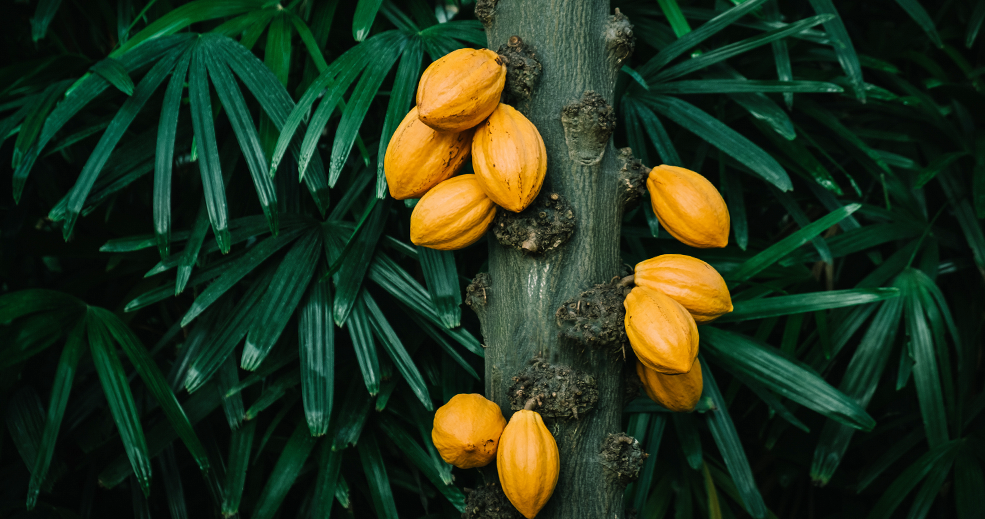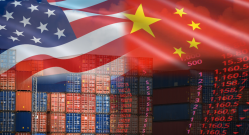
In West Africa, cocoa and deforestation go hand in hand
Cocoa – a key product needed by the West to make chocolate – is mainly grown in sub-Saharan Africa. The region represents 75% of global production and two countries together account for over 50%: Côte d’Ivoire (44%) and Ghana (14.3%). At the regional level, these two countries account for 60% and 19% of Africa’s cocoa production respectively, followed by Cameroon and Nigeria at 8% each.
From the perspective of international trade, Côte d’Ivoire is the world’s leading exporter of cocoa beans, accounting for 42% of exports1, followed by Ghana at 16.2%. Meanwhile, demand is mainly concentrated in the European Union, which accounts for 52.7% of global imports – with 75% of EU imports coming from sub-Saharan Africa. At country level, the top EU importer is the Netherlands, accounting for 33% of EU imports from Africa, followed by Germany (21%) and Belgium (17.5%).
Global cocoa production has been rising steadily for the past 25 years (up 68% between 1997 and 2022), climbing to an all-time high of 5.2 million metric tons in the 2020/2021 season2. This trend has inevitably had consequences for biodiversity, leading to deforestation in Côte d’Ivoire and Ghana as growers have increased production to meet demand. And this expansion of cultivated land boosts cocoa yields: the nutrients that build up in forest systems mean uncultivated forest land is more fertile. As a result, over the past 30 years 90% of Côte d’Ivoire’s forests have been cleared for agricultural production, particularly for cocoa; the equivalent figure in Ghana is 65%. According to Mighty Earth3, This trend has inevitably had consequences for biodiversity, leading to deforestation in Côte d’Ivoire and Ghana as growers have increased production to meet demand. And this expansion of cultivated land boosts cocoa yields: the nutrients that build up in forest systems mean uncultivated forest land is more fertile. As a result, over the past 30 years 90% of Côte d’Ivoire’s forests have been cleared for agricultural production, particularly for cocoa; the equivalent figure in Ghana is 65%. According to Mighty Earth4.
But deforestation is not only a consequence of increased production; it is also explained by poor yields and the low price of cocoa (under $3,000 per metric ton for over six years), which have prompted farmers to up their production. Most are poor small farmers earning less than one dollar a day, well below the $1.90 a day poverty line. This very modest income is down to the large number of links in the supply chain (production, supply, sale, processing and distribution), with producers only receiving around 6% of the profits made on the end product. Another factor driving deforestation is global warming: rising temperatures and drought pose a threat to cacao trees, which need rain and forest cover to protect them from light and wind. The threat of global warming fuels a vicious circle in which producers are driven to move their plantations to mountainous areas, further weakening ecosystems and thus accelerating the phenomenon.
In the long run, unless drastic action is taken, climate change could affect harvests, reducing chocolate production or even wiping out the industry. The data speaks for itself: between the 2020/2021 and 2021/2022 seasons, cocoa bean production in Côte d’Ivoire and Ghana declined by 6% and 64% respectively as a result of severe droughts in West Africa.
Lastly, in an effort to combat deforestation, the European Union has adopted new legislation to prevent imported deforestation. Importing and exporting companies in the EU will henceforth have to prove that their products are “deforestation-free”. Among the affected products, cocoa is one of the main agricultural commodities identified as having a significant impact on forests.
Furthermore, as part of the World Cocoa Foundation’s Cocoa & Forests initiative, Côte d’Ivoire, Ghana and 35 major companies in the sector committed in 2017 to put an end to deforestation and re-establish forested areas. After adopting this strategy, Côte d’Ivoire put in place a nationwide satellite system to monitor deforestation and planted 10 million trees in 2020. Meanwhile, Ghana has restored nearly 226,000 hectares of forest, while companies have achieved 82% and 74% traceability in their direct supply chains in Ghana and Côte d’Ivoire respectively.
1 Source: Trademap data for 2021 – author’s calculations
2 October-September cocoa harvest (International Cocoa Organization)
3 Mighty Earth annual report
4 According to NGO Mighty Earth











